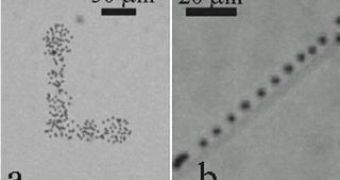Particles being focused and pushed against a substrate by using a laser beam represent the printing process of a new colloidal printer designed by Lars Helseth, scientist at the Nanyang Technological University in Singapore.
Helseth's printer is taking advantage of the electrical and paramagnetic properties of tiny beads and could provide a new printing method that may have applications in printing chemical and biological patterns.
"To the best of my knowledge, this is the first printer based on the laser-pushing of colloids", he said.
The idea came to him after reading about some very interesting experiments done by Arthur Ashkin (scientist who invented the optical tweezers - trapping process used to manipulate atoms, molecules and biological cells- in 1986), who demonstrated how one can push colloids around using optical forces.
Helseth had been recently working a lot with methods for trapping colloidal particles using nanomagnets, and during last year, he has been able to combine the optical and magnetic tweezers in order to probe small forces of femtonewton sizes in particle systems.
In the setup, a green focused optical laser beam with a wavelength of 532 nm transports paramagnetic polystyrene beads - colloids - from a reservoir to a functionalized glass substrate.
The polystyrene beads, less than 3 micrometers, get their paramagnetic behavior from nanoscale iron oxide grains on the beads.
He put the beads on a glass surface which had been negatively charged by a process of rinsing in chemicals and water.
The negatively charged beads fell to the bottom of the glass substrate due to gravity, without attaching to the glass.
Using an objective lens of a microscope to focus the laser beam, the scientist created a focal spot of about 30 micrometers.
With this light spot and about 30 mW of power, the laser could push a single bead against gravity up to a substrate.
Once the particles reached the vicinity of the substrate, they had to be attached using chemical coating and the magnetic charge of the beads themselves and he managed to do so with an accuracy of about 200 nanometers.
Unfortunately, we must withstand the temptation of throwing out the ink cartridge or laser printer at home, because the printing speed is of about 1 micron per second; that means a few minutes for an average-sized letter.
No, not a letter to a friend, this letter : L.
The scientist has good news, for he estimates that by increasing the laser power and decreasing the separation between the two substrates, it should be possible to increase the printing speed to several millimeters per second.
Still not fast enough for you? Well, maybe in the near future, with some improvements, it could become feasible.
One Marketing Director said a few decades ago that the world market had a potential for 4-5 computers, so this new printing technology could find its way into mass-production sooner than you might think !

 14 DAY TRIAL //
14 DAY TRIAL //